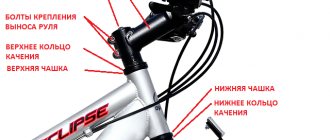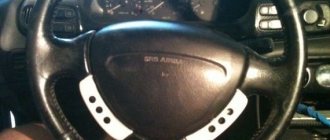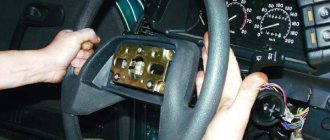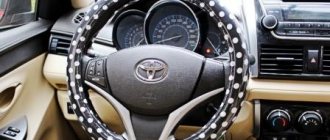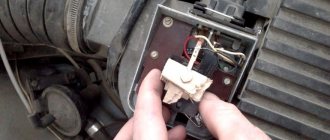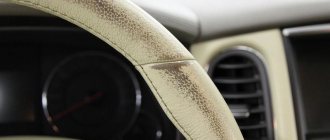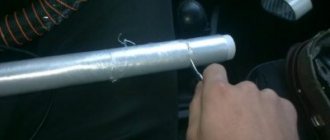If you turn the steering wheel all the way, get out of the car and look at it from the front, you will notice that the wheels are turned at different angles: one is turned out more than the other. But this is not a malfunction, but, on the contrary, an accurate engineering calculation, which celebrates its anniversary this year - it turns exactly 200 years old. Why is the steering designed this way, and why couldn't it be done differently?
The answer to this question lies on the surface: imagine that the car is moving in a circle clockwise - in this case, the circle along which the front right wheel will move will be smaller than the circle described by the left one. Accordingly, at a constant speed of the car, the wheels on the same axle will rotate at different speeds. If the wheels were turned at the same angle, then the inner wheel, trying to move in the same way as the outer one, would constantly slip and cause the outer one to slip - in this case, the behavior of the car in a turn would be unpredictable, and tire wear would be catastrophic. This can be clearly seen on multi-axle trucks and trailers: wheels that do not turn when cornering move with slippage, and the tires wear out quickly and unevenly. Accordingly, to solve these problems and ensure the correct movement of the steered wheels along their trajectory, they turn to different angles.
The very problem of the inner wheel slipping during a turn was relevant long before the mass distribution of cars - after all, horse-drawn carriages had the same problems. Actually, it was on a horse-drawn carriage that steering, which solved this problem, made its debut: in 1817 it was invented by Georg Lankensperger, and in 1918 it was patented in England by his agent Rudolf Ackermann. Since then, the principle of turning the control wheels at different angles during a turn is called the Ackermann principle.
To ensure the required wheel rotation angles, the geometry of the steering linkage is calculated according to a single conventional scheme. In it, the transverse steering rod is shorter than the control axis and is shifted behind it, and the steering steering arms lie on the line between the steering axis of the front wheels and the center of the rear axle of the car. To make it easier to understand this seemingly complex explanation, just look at the simple diagram below.
Accordingly, when the wheels turn in this pattern, they turn at different angles - the inner one turns more, and the outer one turns less. In this case, the centers of the circles along which the wheels move coincide, and the radius of the circle for the outer wheel is actually the turning radius of the car “from curb to curb”, adjusted for the width of the tire.
It is worth noting that the image above is a schematic, and the car's steering is, of course, more complex than what is shown in the diagram. However, the general geometry is valid for all “civilian” cars.
In motorsport, the approach may change: for example, on some racing cars the situation with wheel angles may even be reversed to compensate for lateral wheel slip in high-speed turns, and in drifting they try to make the front wheels parallel even in turns in order to reduce wear on the front tires at constant moving in a controlled drift. But these are extremes that are not relevant for ordinary production cars.
By the way, at the very beginning it was not for nothing that we mentioned not only the different paths that a wheel takes when turning, but also the different speeds of their rotation. In order to ensure that wheels can rotate on the same axle at different speeds, as we have already said, a differential .
10.16.2018 Author: Master Service 5952
Probably, many drivers have heard about the steering angle sensor or steering position sensor, but few people realize the importance of this steering element. Did you know that the operation of the entire electric power steering depends on the condition of the sensor?
Technical information about the sensor
The steering angle sensor is an element of the EUR (EGUR), which determines the position of the steering wheel in the range of 720⁰ in each direction. Most often, the sensor is located on the electric steering column under the steering wheel, less often - on the distributor shaft of the steering rack or above the safety column shaft.
Steering angle sensor for Mercedes-Benz E-Class
What the sensor measures:
- steering angle;
- direction of rotation;
- angular speed.
The sensor is connected to the electric amplifier control unit, which, based on the data received, adjusts the operation of the amplifier electric motor. A working sensor guarantees high accuracy of operation of the electric amplifier.
In addition to the EUR and EGUR, the steering angle sensor can be connected to the following systems:
- directional stability;
- adaptive cruise control;
- lane keeping assistance;
- adaptive lighting;
- active steering;
- active suspension.
US646477–1
None of these patents found their way onto a production car. The first production vehicle with power steering was the five-ton Columbia truck, which was released in 1903. A 1905 Motor Age article raved about how, with this improvement, the heavy truck "kept its course and was easily controlled at 18 miles per hour!" Since then, steering systems based on vacuum or compressed air have found their place in commercial vehicles. The disadvantages of pneumatics include the fact that they were unpleasantly noisy and, due to the high elasticity of the air, could not absorb impacts from road irregularities. While this was tolerable on trucks, it was completely unacceptable on high-speed passenger cars.
Types of steering wheel sensors
Today, few car enthusiasts can be surprised by the presence of a steering wheel angle sensor, but few can understand the importance of the mechanism and its varieties. It is this sensor that controls the steering mechanism, as well as auxiliary safety and comfort systems. The main task of such a mechanism is to read the angle of rotation of the steering wheel. It also calculates the direction of rotation of the steering wheel, and at what speed the car’s steering wheel turns.
Newbie mistake
The first driving lessons for novice motorists are extremely important, but many of them, due to excessive excitement, make a number of significant mistakes. One of them is returning the steering wheel to its extreme starting position after passing a turn. Although the control mechanism is designed in such a way that the steering wheel always, after twisting, automatically returns to a position that corresponds to the vehicle moving in a straight line. Accordingly, he does not require assistance from the driver. Correctly turning the steering wheel of a car first of all means being able to avoid unnecessary hand movements.
The driving process itself is not disrupted, but if a critical situation arises, you need to be able to adequately coordinate your actions.
The video shows the basic hand positions on the steering wheel:
How does the steering angle sensor work?
The simplest among the three listed options is considered to be a potentiometric sensor; it belongs to the category of contact mechanisms. The basis for this type of element is two potentiometers, which are most often installed on the steering column of a car. For the correct operation of this type of mechanism, one of the installed potentiometers is shifted 90 degrees relative to the other.
The second type of steering wheel angle sensor is optical - it belongs to the category of sensor elements. This optical element includes a coding disk, special LEDs, photoresistors for reading information, as well as an electronic unit for determining the full rotation of the steering wheel. Modern manufacturers can video change the device of an element, but the basic device and operating principle remain the same.
The last, third type of steering angle sensor is magnetoresistive. It is this type of element that is most often found in modern cars and has a minimal percentage of breakdowns and defects. Like the previous two types of elements, it also measures the direction, frequency and angle of rotation of the car's steering wheel. Thanks to the device, the electronic control unit more accurately determines the data and sets the speed of the electric power steering.
The list of magnetoresistive elements includes the housing, magnetoresistors, as well as moving magnets. The central part of the element is occupied by large magnetoresistors, also known as GMR elements or their analogues, anisotropic magnetoresistors, labeled as AMR. Thanks to the presence of a gear drive in the mechanism, the moving magnets can rotate. An interesting fact is that each subsequent gear wheel in the sensor mechanism has one tooth more than the previous one; therefore, during repairs, it is worth clearly maintaining the alignment of the installation.
Exercise “Snake” is a very good option for learning how to turn the steering wheel
This exercise is used mainly for practice as drivers studying at an educational institution to obtain a license. A significant mistake when performing the snake exercise is the slow speed of movement and entails a small rotation of the steering column. This action is a mistake! During such a test it is necessary to control the steering wheel intensively, but the speed of the car at this time is extremely low.
Of course, the higher the speed, the easier it is to control the steering column, as well as the small angle when turning at this time. But after completing the training, the motorist will learn all the basics of movement at a low speed, and will acquire sufficient knowledge and experience, will know how to control the steering wheel without much effort. In the same way, such an ability as reaction will become clear. And its essence is when you turn the steering wheel to a level position, but the car still moves towards a sharp maneuver for a few seconds. Having passed such a test as a snake perfectly, the student will pass all subsequent tests without problems.
It is important for every motorist to know how to handle the steering wheel, and this also applies to every vehicle owner. Only by knowing all the aspects, in a difficult and dangerous situation, they will be able to save your life and passengers, as well as your transport from a crash.
How does the steering sensor work?
First on the list is a potentiometer-based steering angle sensor. The design of such a mechanism has already been discussed above; as for the principle of operation, it is simple, with an increase in the angle of rotation of the steering wheel, the resistance on the potentiometer increases. The resistance of the element is proportional to the steering angle.
The advantage of this type is the simplicity of the design, but the disadvantages are the unreliable design. Most often, a potentiometric sensor is installed on budget models or they try to completely eradicate it from the steering mechanism. Accordingly, it is very rare on modern cars.
Second sensor
– optical, its operating principle is much more complex than the first, but accordingly the quality of work is an order of magnitude better. The main function of the work is performed by a coding disk, which is attached to the steering column shaft of the car. The disc consists of outer and inner rings. As a rule, there are several uniform holes located on the inner ring, while the holes are unevenly located on the outer ring.
The operating principle of such a sensor is not complicated: when the driver turns the steering wheel, light from the LEDs hits the photoresistors. At this moment, the electrical circuit generates voltage, the holes in the rings interrupt the beam of light, and the voltage changes accordingly. The electronic control unit reads data regarding the appearance of voltage pulses, their frequency and code (because of this, the parts are called a code disk). In accordance with the data obtained, the direction of rotation of the steering wheel and the angle of the steering wheel of the car are calculated. It is due to this device that optical sensors are more common in modern cars.
The last type of sensor whose operating principle is worth considering is magnetoresistive. Unlike the previous two elements, the work of this type is more complicated. Each turn of the steering wheel receives its specific position of the moving magnets of the element. In turn, magnetoresistors determine the position of the moving magnets and transmit information to the electronic control unit. Based on the data received, the ECU calculates the steering angle, speed, and direction. Thanks to this device and precision of operation, magnetoresistive elements are considered the most reliable and widespread in modern cars.
Smooth turns
They pass from position 9 - 3, usually these are turns either at high speeds or not so steep. With both hands from “nine - three”, we move the steering wheel to the right or left, usually in this way you can turn no more than 25 degrees. Of course, you can make a sharper maneuver, but it will be convenient for you to cross your arms; here you already need the skill of performing medium maneuvers. You can train in this way on the highway (where speeds are higher than city speeds), where you will need this type of maneuver.
maneuver from position 9 - 3
What are the possible breakdowns of steering sensors?
As they say, nothing is perfect, and accordingly, the steering angle sensors also fail. Since this is an electromechanical component of the car, it is much more difficult to determine the breakdown and a driver without experience simply will not be able to understand whether the element is working or not. The weakest points of such elements are considered to be wiring and metal elements, since they are constantly moving.
A common problem can be a protective boot on the camshaft. If it breaks, the shaft begins to rust; failure to correct the problem in a timely manner can bring rust to the sensor, which means it will quickly fail. Dust and moisture also have a detrimental effect on the steering angle mechanism. This is especially true when the mechanism is located on the steering rack. As practice shows, in most cases the electrical circuit or the electronics itself fails first. This situation is much worse than all the others; in the best case, the sensor will completely fail; in the worst case, it will transmit false data and incorrectly determine the steering angle, direction and speed.
Whatever the type of steering angle element, it is a precise and fragile mechanism. Experts say: if the physical zero is shifted, the geometry is broken, or the battery is disconnected, then the readings of the angle element may not be accurate. There are several ways to determine whether the steering angle sensor is broken or malfunctioning. The first is an indicator on the instrument panel, yellow is a sign of an operating error, red is a complete shutdown of the mechanism. The indicator itself looks like a steering wheel and can blink or be constantly on.
A few more signs of a malfunction in the steering angle mechanism are that the steering wheel rotates tightly, may rotate jerkily, dips appear, or jerks from side to side. The most common sign of a sensor failure is a delayed response of the wheels to the steering wheel, as a result of which the car drives from side to side.
mercury_park_lane
Mercury Park Lane
Competitors Chrysler and GM also carried out their own developments, and very original ones. So, in 1965, Ford released and handed over to the media for testing several Mercury Park Lane cars with two small steering wheels located on the sides of the steering column and connected by a chain drive. The small (127 mm) steering “rings” had a very high gear ratio (15:01) and a backup electro-hydraulic pump. The futuristic-looking steering wheel made it possible to steer the huge sedan into a turn with literally one movement of the wrist or thumb, for which it received the name wrist-twist instant steering from the enthusiastic press.
They did not lag behind the Americans in Europe. The French from Citroën amazed the automotive world with their DIRAVI system in 1970. This acronym from the French Direction à rappel asservi means "control with controlled return". In the UK the system was sold under the name Varipower and in the US as SpeedFeel. It was the first commercially available variable-assist power steering. While actively assisting at low speeds, it had less impact on high-speed handling. The DIRAVI system was an addition to Citroën's integrated hydropneumatic suspension and braking system, but apart from its hydraulic part, it was independent of it.
Citroën's design stood out in that it did not have a direct mechanical connection between the steering wheel and the wheels during normal operation of the system. The amplifier worked even when the engine was turned off, the steering wheel automatically returned to the middle position, and the force on it varied in proportion to the speed and angle of rotation of the wheels. A car with DIRAVI could drive straight, maintaining its course regardless of whether there were potholes or ruts on its way - the change in direction was carried out only by the will of the driver!
The disadvantages of DIRAVI included its sensitivity and high response speed, which required some getting used to. Additionally, the driver had to look for visual cues to determine the road's grip limit.
The system was used on Citroën SM, Citroen CX, Citroen XM with V6 engine, Maserati Quattroporte II, Maserati Khamsin.
In 1986, one of the first mass-produced speed-sensitive power steering systems was released under the Servotronic brand. The design, developed by the German companies ZF Friedrichshafen AG and Robert Bosch GmbH, has been adopted by more than a dozen leading brands.
Pros and cons of having an angle sensor
Having a steering angle sensor in a car is always a plus. Firstly, an electric power steering will be installed in parallel, and secondly, many active security systems can be installed on board the car. For example, a lane monitoring system, adaptive cruise control and others. The system carries out assigned tasks, accurately follows the driver’s instructions and improves vehicle safety.
Among the disadvantages of the steering angle sensor is the possibility of rapid failure at the most inopportune moment. In the event of a breakdown, many talk about expensive maintenance, and in most cases it will be necessary to go to a special service center. In other words, if a steering angle element fails, it is almost impossible to repair it yourself, or you need to look for a donor. Another disadvantage is that, like your favorite electronics, over time the mechanism may begin to malfunction, which means that other active security systems will not work well.
Let's move back.
Turn your head back and to the right, sitting half sideways (you can forget for a while the words of those instructors who taught you to drive “by mirrors”), this way you will provide yourself with a good view.
In the case when reverse requires moving straight or to the right, your right hand should be kept on the back of the adjacent passenger seat, and your left hand, respectively, on the steering wheel, using it to regulate the rotation (straightness of movement) of the car. When moving to the left, we do the same, but in a mirror image.
How to handle the steering wheel correctly is one of the main tasks for inexperienced drivers. With such knowledge of handling the steering wheel, the driver may not get into awkward situations along the way. But if you treat this carelessly, such actions can lead to trouble. The steering column is controlled by the driver's hands for efficient and smooth movement of the vehicle. You can learn to rotate the steering wheel at home with the help of simulators, but you can do it yourself.
Classification of hand movements:
1. Type of working movement - when you take the steering wheel, it begins, and ends during its release.
2. Type of idle movement - carries such an action in the interval between releasing the steering wheel and its next capture.
3.Release and pick up the steering wheel while turning it - the steering should not end in this case.
Car steering angle sensor price
The cost of a car steering angle sensor largely depends on the brand, model, as well as on the type of element itself. The same mechanism in appearance will not fit different cars. Car manufacturers make various fasteners, contact strips and other tricks to minimize the possibility of self-repair or replacement.
| Approximate price of steering angle sensor | |
| Car make and model | Price from, $ dollars |
| Opel Vivaro | 30 |
| Mercedes-Benz ML | 100 |
| Lexus RX300/330/350/400 | 80 |
| Subaru Forester S12 2007 | 110 |
| Mercedes-Benz Vito W639 | 16 |
| Nissan Leaf | 81 |
Prices are based on magnetoresistive sensors. Despite the fact that the structure of the structure and the principle of operation are the same, they differ significantly in appearance, and similarly differ in fasteners. Whether the presence of such a sensor in a car is positive or negative is everyone’s opinion. As statistics and practice show, most automobile manufacturers implement such a mechanism, since active safety systems are built on its basis. Accordingly, driving becomes easier for the driver and safety increases.
Video review of replacing the steering angle sensor on a Hyundai Tucson:
Rotating the steering wheel when reversing
How to turn the steering wheel correctly when reversing
Reversing can be done in two ways: using the mirrors as a guide and looking behind you. Reversing with your head turned back provides better visibility. This method will allow you to notice a pedestrian or another car that may appear unexpectedly. This maneuver can be learned quickly if you follow strict rules.
- In a left-hand drive car, you need to turn semi-sideways to the right and look in the direction of travel.
- If reverse involves moving straight or to the right, then the right hand should lie on the back of the seat next to it, while the left hand is on the steering wheel.
- If you need to turn left in reverse, then you need to sit with your half-side turned to the left. In this case, the elbow of your left hand should rest on the back of the driver’s seat. In this case, you need to steer only with your right hand.
A simulator for practicing steering skills
The simulator is easy to make yourself
To consolidate all the necessary skills, a simulator will help. You can make it yourself and use it while sitting on a chair or in the front passenger seat of a car. First you need to make a platform. This can be a rectangular wooden board on which you need to nail, glue, or best of all, fix the stand with corners.
- If the simulator is intended for home purposes, then install the stand in the middle of the board.
- If the simulator is intended for a car, then we nail the stand closer to the front edge of the board.
Next, you need to install the steering wheel on this rack. To do this, we attach a medium-sized bearing to the steering wheel with a bolt, which we fix to any metal plate by welding. All that remains is to attach it to the top of the rack.
If the exercise machine is placed in the car, in front of the front passenger seat, then during exercise your knees should clasp the counter between your legs.
Such a simulator, of course, will not help you master all driving skills. However, you will learn how to turn the steering wheel correctly and will be able to hone your skills to the point of automaticity.
